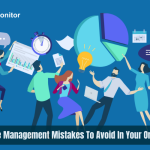Are you trying to figure out how to draw the best talent for your company while also cutting back on recruitment costs?
Employee retention can be a useful tool, even though you may not have thought about it before. You can build an environment that will draw top talent while keeping your current employees engaged and satisfied by understanding why employees remain and giving them significant opportunities.
In addition to saving time & resources, knowing about employee retention strategies will also avoid the agony of losing and having to replace exceptional talent at a time when the Great Resignation shows no signs of slowing down.
Even if you can’t forbid every employee from looking for a new job, all departing employees feel their manager or company could have stopped them from quitting their position.
Read on to know more-
What is Employee Retention?
Employee retention refers to the steps a business takes to inspire its team to work there for a very long time. Employee turnover, which describes the rate at which employees depart the organization, is the opposite of this. Because it can result in the loss of institutional knowledge and skills, as well as higher training and recruitment costs, high employee turnover can be pricey and disruptive for a business.
Therefore, to maintain a steady & engaged workforce, many businesses invest in employee retention initiatives and methods and make sure it’s a core component of their business strategy.
These could include things like fair wages & benefits, chances for professional growth, flexible work schedules, and supportive workplace culture.
Why Employee Retention is Important
Reportedly, American businesses lose $1 trillion annually due to turnover.
Indeed, you read that correctly. Businesses should give employee retention endeavors the highest priority for a trillion reasons worth a trillion dollars.
How come the price is so high? There are a variety of expenses to consider when employees depart a company, such as:
- Time and resources needed to hire a replacement (including recruitment and onboarding of new talent)
- Decreased morale of the remaining employees
- Decreased output during the hiring and onboarding process.
- Skill and business knowledge lost.
According to estimates, replacing an employee might cost between 50% and twice their annual income. However, businesses that retain their employees and engage in employee retention efforts for longer can gain in ways beyond reduced hiring and training expenses.
Employee retention results in:
- Improved client experiences
- Improved corporate culture (which supports employee engagement & employee retention)
- Momentum, loyalty, and consistency across teams and the company.
Additionally, businesses find it easier to hire the right talent for the position when turnover is low, and engagement is high. In other words, your business should prioritize employee welfare and look for every chance to increase engagement and employee retention.
Top Reasons Employees Leave their Jobs
Employee hiring and training are expensive processes. Onboarding and training new employees costs businesses, on average, close to $2,000. If things don’t work out, the financial situation is significantly worse: annual losses resulting from staff turnover totaling more than $11 billion. (As per reports)
However, why do people leave their jobs? The most typical causes are listed below:
- Insufficient opportunities for career advancement
- Poor company culture and low team engagement
- Poor salary and no benefits
- Disagreements with the management or other employees
- Lack of direction or goals for the business
- Employees feel their candid opinions & thoughts are not considered.
An employee may leave their current position for a variety of reasons.
- Toxic Company Culture: 1,000 U.S. employees left their jobs in 2022, and a poll conducted in 2022 found that more than 30% of them identified toxic culture as the main reason for their departure. Discrimination in the workplace, verbal abuse, and poor communication have no place in an environment that values employee retention.
- Lack of Appreciation & Opportunities: People frequently “drop out” when they don’t feel appreciated. More than 65% of employees said they would leave their jobs if they sensed their hard work or above-and-beyond efforts went unrecognized.
- No Choices for Flexible Work: People learned they didn’t need to be in the office all the time when the globe became online in 2020. Lack of schedule flexibility or remote work options makes employees more prone than ever to leave their jobs.
- Feeling Burned Out: People are more easily affected by poor work-life balance and burnout when budget cuts and stakes are high. They might depart in search of positions with lower levels of stress. Burnout-related resignations are particularly common among Gen Z and Millennial employees.
- Lack of Career Development Opportunities– In a study of more than 6,000 working adult Americans conducted in 2021, more than 60% of respondents cited a lack of career growth prospects as the main factor in their decision to leave their employment. People desire to feel as though they have room for advancement in their current line of work.
- Low Salary: Due to the rising cost of living, employees are looking for jobs with the highest pay and benefits in tune with their skills & qualifications. People desire to receive compensation commensurate with their abilities and market value. Pay transparency is a significant shift in the market as a result.
- Management Issues: Poor management is the main reason for low employee retention rates. In a recent poll of more than 2,000 employees from 15+ different industries, findings reflected that 60% of respondents attributed their desire to quit their jobs within the next year to a narcissistic boss.
- Lack of Integrity, Honesty, and Ethics– Ethics & morals are frequently as important as or even more important than money, according to many job hopefuls. In fact, 73% of professionals claim to consider an organization’s principles and would not submit an application to a company unless those values were compatible with their own. Further, 82% of employees say they would rather accept a lower salary and work for an association that upholds ethical standards than a greater salary at one that doesn’t.
What Does Losing an Employee Cost?
- Recruitment Expenses: These are the upfront expenditures associated with finding, interviewing, screening, and hiring a new employee.
- Onboarding Cost– Costs associated with bringing on a new employee, including time spent on training them.
- Lost Productivity– Lost productivity might result in indirect expenditures for your company because it can take a new employee one to two years to meet an existing employee’s productivity level.
- Loss of Engagement and its Effect on Employee Morale: When there is a high turnover rate, other employees become disengaged and less productive, which lowers team morale.
- Errors & Customer Service: New hires frequently make more mistakes than veteran team members do. They also take longer to accomplish their work.
- Costs of Training – Businesses typically spend 10% to 20% or more of an employee’s compensation on training over a 2-3-year period.
- Loss of Institutional Knowledge– When highly talented or long-tenured people depart, your organization loses some institutional knowledge, or the collective skill set and experience of your business.
- Cultural Repercussion: People always take the time to ask why when someone leaves.
Employee Retention: The Need and Importance
Let’s discuss why keeping a valuable employee on board is crucial for a company.
-
It’s not simple to hire someone:
Finding the ideal candidate requires a lot of time.
The HR professional selects a small number of candidates from a broad talent pool, performs preliminary interviews, and then transmits the information to the various line managers, who further question the candidates to determine whether or not they are a good match for the firm.
-
An organization spends time & resources to develop a person, get him job ready for the workplace, and help him get to know the corporate culture:
The management works hard to train a new hire for his entire development because he is raw & untrained in the processes.
Both time and money are lost when someone leaves a company unexpectedly. Therefore, employee retention strategies are essential.
For the same space, HR has to reopen the hiring process from scratch, resulting in a simple duplication of effort. Finding the ideal employee for a company is a difficult task, and all the training efforts go in vain when an employee goes.
-
Long-term employees are more familiar with the rules and regulations of the organization, which helps them adjust more easily:
They fare better than those who regularly change employment. Long-term employees can make valuable contributions since they are familiar with the business inside and out.
-
Retaining valuable employees that are exhibiting promise is compulsory for the business.
For a company to succeed, its team needs to commit. People with talent and the ability to think of something truly original & innovative are highly valued assets for any organization. If every star employee goes, no business can survive.
It’s important to keep the employees that work hard and are essential to the business’s operations.
The management must be able to distinguish between a valued employee and one who doesn’t significantly grow the business. Sincere initiatives, such as an employee retention program, must be implemented to inspire the employees to stay satisfied in their roles and resist the impulse to go elsewhere.
-
It is more likely that a person who leaves his current business will work for one of its rivals:
In such circumstances, employees often share all current corporate tactics and policies with new ones. People bring all the relevant facts, figures, and statistics to their new workplace, and in certain cases, they even divulge the secrets of the preceding business.
The new hire must sign a paper prohibiting him from disclosing any information even if he leaves the business to prevent situations like these from occurring. Make a strict policy to stop the team from working for rival companies. This works well for keeping employees on board and is a great employee retention strategy.
-
People that stay with an organization for a longer period tend to be more devoted to the leadership and the business:
They receive considerable advantages from the company, which makes them feel more devoted to it. They never belittle their company and almost seldom criticize the management. They prioritize organization over all other considerations.
-
Every person requires some time to get acclimated to the official environment:
It takes time to get to know one’s team members well, become friends with them, and ultimately develop trust in them. When employees get along well with one another and collaborate to find solutions that benefit everyone, businesses always stand to gain.
Adjustment issues arise when a new employee takes over for an old one. It can be very challenging to gauge how comfortable the other person is with them. It might be complex for new hires to fit in with existing team members after building rapport with them, let alone gain their trust.
A human disposition is to constantly look for issues in a new hire by comparing him to the previous employees.
Read More-
8 Vital Elements to Boost Your Company’s Employee Engagement & Retention
07 Benefits of Employees Working from Home
How to Measure Employee Engagement at Your Workplace?
Final Words
To keep your best employees on board as the labor market tightens, you should be aware of employee retention and concepts for increasing retention levels at your company.
We encourage you to perform research, invest in employee engagement programs, and monitor the impact different employee retention ideas/ strategies are having on your retention rate.
Last but not least, use EmpMonitor to understand more about employee behaviors and work habits so that you can focus more on employee retention of productive employees.
Book a Demo Now-












